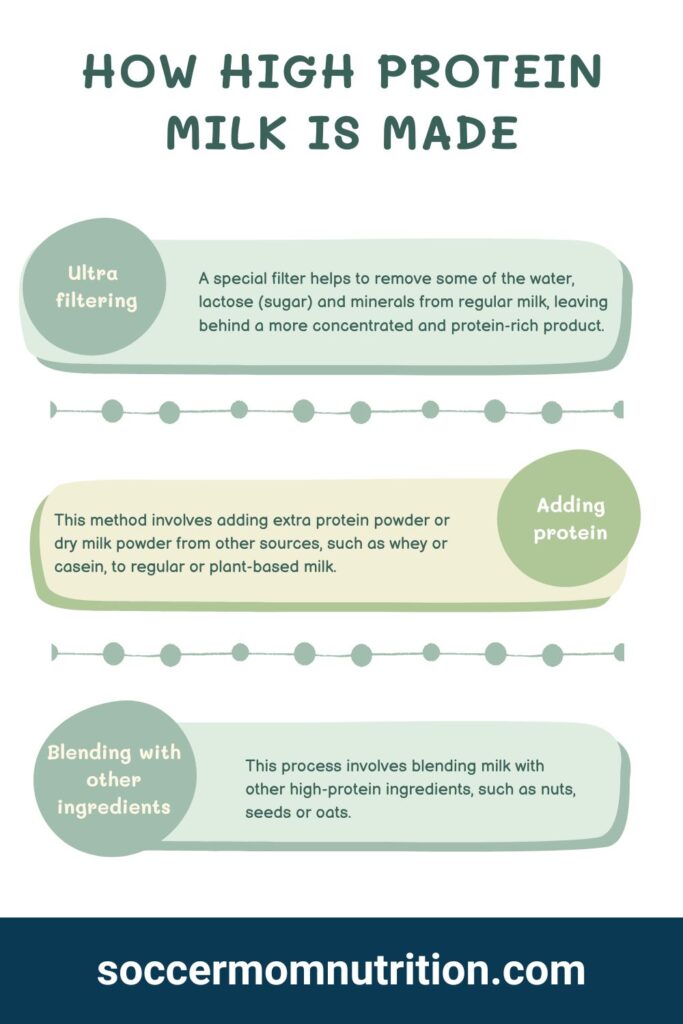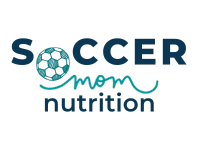8 High Protein Milk Products to Boost Protein Intake
When it comes to fueling your body, high protein milk is an excellent choice that provides essential nutrients. In fact, high protein milk boasts a higher protein and calcium content than regular milk.
In this post, we will share our top brand recommendations, including high protein milk alternative options, such as plant based milks and discuss the best ways to incorporate them into your daily meals and snacks.
Read on to learn more about our top recommendations for high protein milk brands.

Please note that this article contains affiliate links. If you click one of these links and make a purchase, we may earn a commission. As an Amazon Associate, we earn from qualifying purchases.
What is high protein milk?
High protein milk is milk processed to increase its protein content and reduce its sugar and fat content. There are three main processes to make high protein milk including ultra filtering, adding protein and blending multiple high protein ingredients.
The protein content of high protein milk can vary depending on the type and brand, but it is usually between 10 to 13 grams per cup (240 ml), compared to 8 grams per cup (240 ml) in regular cow’s milk.
Nutrient contents of high protein milk
High protein milk nutrition provides a complete source of protein, providing all nine essential amino acids. Additionally, like regular milk, high protein milk contains a good or excellent source of 13 essential nutrients.
These essential nutrients include protein, calcium, phosphorous, vitamin D, phosphorous, vitamin A, riboflavin, vitamin B12, pantothenic acid, niacin, potassium, iodine, selenium and zinc.
| Brand | Protein (g) | Sugar (g) | Fat (g) | Calcium (%) | Vitamin D (%) | Lactose free |
|---|---|---|---|---|---|---|
| Darigold FIT® 2% | 14 | 7 | 5 | 30 | 15 | Yes |
| H‑E‑B MooTopia™ 2% | 13 | 6 | 5 | 35 | 15 | Yes |
| Fairlife® 2% | 13 | 6 | 5 | 30 | 25 | Yes |
| LACTAID® Lactose-Free | 13 | 11 | 9 | 35 | 15 | Yes |

Ultra filtered high protein milk brands
Our top picks for high protein milk brands include some shelf stable options as well as a lactose free option for those who have issues with digesting lactose.
Fairlife® ultra-filtered milk
Fairlife is a brand of high protein milk that uses a patented cold-filtration process to remove lactose and concentrate the protein and calcium in the milk. It has 50% more protein and 50% less sugar than regular milk.
This means it has 13 grams of protein and 6 grams of sugar per 8-ounce serving. Fairlife® ultra-filtered milk also claims to have a longer shelf life than regular milk due to its filtration process.
Darigold® FIT ultra filtered milk
Darigold is another brand of milk that uses ultra-filtration to create a lactose-free, high-protein, low-sugar product.
It has 75% more protein and 40% less sugar than regular milk, which means it has 14 grams of protein and 5 grams of sugar per 8-ounce serving.
Darigold® FIT ultra filtered milk also offers a chocolate flavor that has more protein than regular chocolate milk.
H‑E‑B MooTopia™
H-E-B is a brand of ultra-filtered milk that is available at H-E-B grocery stores. It has 50% more protein and 50% less sugar than regular milk with 13 grams of protein and 6 grams of sugar per 8-ounce serving.
H‑E‑B MooTopia™ is also lactose-free and enriched with vitamins A and D.
LACTAID® Lactose-Free 2% Reduced Fat High Protein Milk
LACTAID is a brand of milk that is specially made for people who are lactose intolerant. It has about 50% more protein than regular milk, 13 grams per 8-ounce serving, but it has less sugar with 11 grams per serving.
LACTAID® Lactose-Free ultra filtered milk also contains the natural enzyme lactase, which helps break down lactose and make it easier to digest.
Plant-based high protein milk alternatives
If you are vegan, lactose intolerant or allergic to dairy, there are more limited plant based high protein milk alternative options. However there are still great choices on store shelves.
Since plant based high protein milk alternative options can vary from brand to brand, it’s important to read the labels to make sure you’re getting the protein, vitamin and minerals that you need.
Most soy milk brands have about 8 grams of protein per cup (240 ml), which is similar to cow’s milk. However, some plant based brands have more or less protein depending on the ingredients and processing.
Our top picks for plant based high protein milk alternative (at least 8 g protein)
Edensoy extra plain
Edensoy Extra Plain soy milk has 13 grams of protein per cup (240 ml) from organic soybeans and added organic soy protein, 1 gram of fiber and fortified with calcium.
Silk protein original
Silk Protein Original contains 8 grams of protein per cup (240 ml) from soy protein isolate and pea protein, 2 grams of fiber and is fortified with calcium and vitamin D. It is sweetened with cane sugar and has a lightly sweet flavor.
Orgain organic protein almond milk
Orgain Organic Protein Almond Milk has10 grams of protein per cup (240 ml) from organic pea protein and organic almond, 1 gram of fiber and is fortified with calcium and vitamin D. It’s an unsweetened vanilla flavor.
Silk® almond & cashew protein milk
Silk Almond & Cashew Protein Milk has 10 grams of protein per cup (240 ml) from pea protein, almonds and cashews, 2 grams of sugar and is an excellent source of calcium and vitamin D. It’s smooth and creamy and one of our favorites.
As far as other plant based milks, pea milk has about 8 grams of protein per cup and also contains additional vitamins and minerals such as calcium, iron and vitamin D, which are often added to plant-based milks.
How protein content is increased in milk
1. Ultra filtering
Ultra filtering is a way to make milk more protein-rich by removing some of the water, sugar and minerals. It uses a special filter that only lets the smaller parts of milk go through, and keeps the bigger parts like protein and fat.
This makes the milk thicker and creamier, with about 50% more protein than regular milk. Ultra filtering also reduces the lactose content, so people who have trouble digesting lactose can drink it.
Ultra filtered milk can be used for making cheese, yogurt or other dairy foods.
2. Adding protein
Adding protein is another way to increase the protein content of milk. This method involves adding extra protein powder or dry milk powder from other sources, such as whey or casein, to regular or plant-based milk.
Whey and casein are the two main types of protein found in milk, and they have different properties and benefits.
Whey is a fast-digesting protein that stimulates muscle growth and repair, while casein is a slow-digesting protein that provides a sustained release of amino acids and prevents muscle breakdown.
Adding protein powder or dry milk powder can also enhance the flavor and texture.
3. Blending with other ingredients
Blending with other ingredients is another way to increase the protein content of milk. This process involves blending milk with other high-protein ingredients, such as nuts, seeds or oats.
Nuts and seeds are rich in plant-based protein, healthy fats, fiber and antioxidants. They can also add flavor to milk.
Oats are a good source of complex carbohydrates, soluble fiber, and beta-glucan, a type of fiber that can lower cholesterol and blood sugar levels. Blending with other ingredients can also make milk more filling and satisfying.

4 High protein milk benefits for athletes
High protein milk benefits athletes in several ways when added to an overall athlete meal plan.
1. Supporting muscle growth and repair
Protein is essential for building new muscle tissue and repairing the damage caused by exercise. High protein milk provides a complete source of protein.
2. Enhancing hydration and electrolyte balance
Milk is naturally rich in water and electrolytes. These are important for maintaining fluid balance and preventing dehydration and cramps during and after exercise.
High protein milk can help replenish these losses and keep you hydrated. It makes a great recovery drink and a good post game soccer snack paired with a banana or other high carb food.
3. Boosting bone health
Milk is one of the best sources of calcium, which is key for bone health and strength. Calcium also helps with muscle contraction and nerve function.
These high protein milks can provide more calcium than regular milk or some plant-based milks that are not fortified. For example, Fairlife® ultra-filtered milk has 30% more calcium than regular milk.
4. Improving satiety
Protein is known to be more filling than carbs or fat. High protein milk can help you feel full for longer and stabilize your blood sugar.

When to drink high protein milk
The best time to drink high protein milk is within 30 minutes after exercise, since this is the optimal window for muscle protein synthesis.
Drinking high protein milk with a high carbohydrate food after exercise can help replenish your muscle glycogen stores, stimulate muscle growth and repair, reduce muscle soreness and enhance hydration.
You can also drink high protein milk before sleep, as this can provide a sustained source of energy and prevent muscle breakdown. In addition, the casein in the milk may help you to fall asleep. (1)
Top ways to use high protein milk in your diet
Drinking it plain or flavored
You can enjoy it as a refreshing drink by itself or with some natural flavorings, such as cocoa powder, vanilla extract or cinnamon. High protein milk makes a great recovery drink paired with high carb options for an post game snack.
Some brands, like Fairlife, sell ready-to-drink flavors, such as chocolate, vanilla or strawberry. However you should review the ingredients because some use artificial sweeteners, sugar alcohols or sugar.
Adding it to smoothies or shakes
Blend in as a base for your smoothies or shakes and add your favorite fruits, vegetables, nuts, seeds or other ingredients.
This can make a delicious and nutritious breakfast, snack or post game treat that will top off your fuel stores or assist recovery.
Mixing it with cereal or oatmeal
Use high protein milk instead of regular milk or water to prepare your cereal, oatmeal or even overnight oats. This can boost the protein content of your breakfast meal or snack and make it more satisfying and balanced.

Cooking or baking with it
Add to your favorite recipes that call for regular milk, such as soups, sauces, casseroles, muffins, pancakes or cakes. This increases the protein content of your dishes without affecting the taste or texture.
FAQs about high protein milk
Final thoughts
High protein milk is an easy, tasty and healthy way to meet your protein needs throughout the day.
Protein has many benefits, such as enhancing your hydration, bone health, satiety and weight management. For athletes and active people, it also helps you recover faster and perform better.
You can enjoy these milk products in many ways, such as drinking it plain or flavored. Try blending it with fruits or vegetables, stirring it with cereal or oatmeal or using it for cooking or baking.
Join our mailing list and get our FREE Pre-Activity Fueling Guide.
Stephanie Magill, MS, RD, CD, FAND has over 22 years of experience in public health and nutrition. As a performance registered dietitian nutritionist, Stephanie specializes in sports nutrition and provides simple and actionable information so that athletes can be well fueled for high performance on and off the field. Stephanie has a Master’s Degree in Nutrition and is a Fellow of the Academy of Nutrition and Dietetics.









